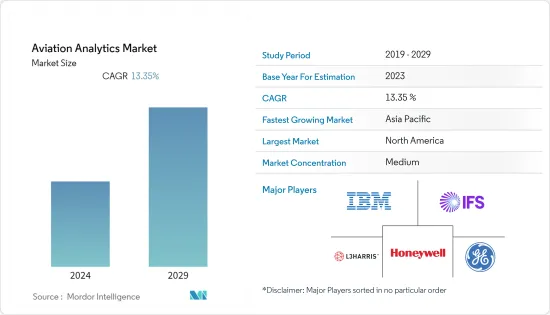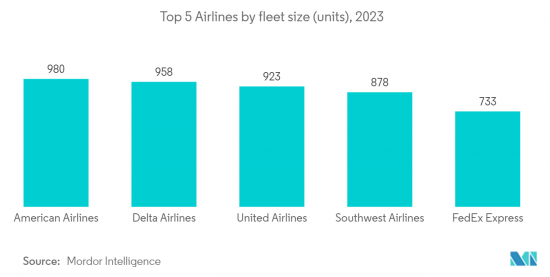
|
시장보고서
상품코드
1408559
항공 분석 : 시장 점유율 분석, 산업 동향과 통계, 성장 예측(2024-2029년)Aviation Analytics - Market Share Analysis, Industry Trends & Statistics, Growth Forecasts 2024 - 2029 |
||||||
2024년 항공 분석 시장의 시장 규모는 36억 5,000만 달러로 예측 기간(2024-2029년) 동안 13.35%의 CAGR을 기록하며 2029년에는 68억 2,000만 달러로 성장할 것으로 예상됩니다.

데이터 분석은 효율성 향상, 고객 경험 개선, 보안 강화, 비용 절감과 같은 가치 있는 이점을 제공하기 때문에 항공 산업에서 중요한 역할을 하고 있습니다. 비지니스 운영 최적화에 대한 수요 증가는 항공 분석 시장을 이끄는 주요 요인 중 하나입니다. 시장 성장은 항공 산업에서 비지니스 기능 전반에 걸쳐 고급 분석 솔루션의 채택이 증가함에 따라 시장 성장에 기여하고 있습니다. 항공사는 항공 운영 관리의 다양한 측면에서 분석을 광범위하게 채택하고 있습니다. 예를 들어, 항공사는 머신러닝 알고리즘이 내장된 애널리틱스를 통해 각 노선의 거리와 고도, 항공기 종류와 무게, 날씨 등에 대한 비행 데이터를 수집하고 분석합니다. 그 결과를 바탕으로 시스템은 비행에 필요한 최적의 연료량을 추정합니다. 또한, 공항 운영의 디지털화 및 인적 간섭 감소에 대한 관심이 높아지면서 항공 분석 시장에 기회를 제공하고 있습니다. 그러나 기존 장비와 최신 기술의 통합에 대한 전문 지식의 부족은 예측 기간 동안 시장 성장을 억제할 것으로 보입니다.
항공 분석 시장 동향
예측기간 중 가장 높은 성장세를 보일 것으로 예상되는 항공 부문
증가하는 여객 수송 수요에 대응하기 위해 전 세계 항공사들은 기존 항공기를 확장하고 현대화하기 위해 노력하고 있습니다. 예를 들어, 2022년 11월 에티오피아 항공 그룹은 2035년까지 보유 항공기를 140대(현재)에서 271대로 늘리겠다고 발표했습니다. 이를 위해 이 항공사는 최소 130대의 항공기를 추가하고 노후 항공기를 교체하는 것을 고려하고 있습니다. 위드에어 역시 2023년 6월, 2024년 말까지 보유 항공기를 200대 이상으로 늘린다는 계획을 발표했습니다. 2021년 9월 유나이티드항공은 보잉과 에어버스 단항기 270대를 주문해 보유 기종과 평균 기종 수를 늘렸고, 2030년까지 500대 이상의 항공기를 보유하는 것을 목표로 하고 있습니다. 이러한 항공기 보유 대수의 증가는 기체 관리, 연료 관리, 수익 관리 등 여러 애플리케이션에 대한 항공 분석에 대한 수요를 동시에 창출할 것입니다.
항공사들은 비지니스 운영에 분석 기술을 도입하는 추세가 점점 더 강해지고 있습니다. 이와 관련, 아메리칸 항공과 마이크로소프트는 지난 5월 기술을 활용해 고객과 아메리칸 항공 팀원들에게 더 나은 연결 경험을 제공하기 위해 파트너십을 체결한 바 있습니다. 이 제휴의 일환으로 아메리칸 항공은 항공사 애플리케이션과 주요 워크로드를 위해 Microsoft Azure를 우선적인 클라우드 플랫폼으로 사용할 것입니다.

아시아태평양이 예측 기간 동안 급성장할 것임
아시아태평양은 예측 기간 동안 가장 높은 성장을 보일 것으로 예상되며, IATA에 따르면 아시아태평양 항공사의 2023년 7월 트래픽은 2022년 7 월에 비해 105.8 % 증가하여 계속해서 이 지역을 선도하고 있습니다. 2023년 6월 인도 MRO협회가 발표한 바에 따르면 인도 항공사들은 매년 100-110대의 항공기를 추가해 2027년까지 약 1,200대의 항공기를 도입해 매년 15%의 항공기 용량을 늘릴 것이라고 밝혔습니다. 매년 15%씩 항공기 용량을 확대할 예정입니다. 에어인디아는 당면한 수요를 충족시키기 위해 적극적으로 신형 항공기를 도입하여 2024년까지 50대의 좁은 몸체 항공기와 19대의 넓은 몸체 항공기를 추가할 예정입니다. 마찬가지로 2023년 4월 중국항공은 보잉 B787 기종 8대를 주문했습니다. 항공기 규모가 확대됨에 따라 항공 분석의 활용을 통해 운항 및 항공기 관리 문제를 간소화할 필요가 있습니다. 2023년 6월, RTX의 운영사인 콜린스 에어로스페이스와 일본항공(JAL)은 JAL이 보잉 B787 기종에 콜린스 에어로스페이스의 Ascentia 유지보수 및 성능 모니터링 솔루션을 도입하기로 합의했습니다. 성능 모니터링 솔루션을 도입한다고 발표했습니다. 아시아태평양의 숙련된 인력과 작업 공간 확보도 이 지역의 항공 분석 시장을 견인하는 요인입니다.
항공 분석 산업 개요
항공 분석 시장은 IBM Corporation, IFS, Honeywell International Inc, L3Harris Technologies, Inc, GE Digital(General Electric Company) 등 주요 기업들이 시장 점유율을 차지하고 있습니다. 큰 비중을 차지하고 있으며, 통합되어 있습니다. 항공업계의 주요 기업들과 장기 계약을 체결하기 위해 이들 기업들 간의 경쟁이 치열합니다. 이들 업체는 특히 자산 관리 및 영업 및 마케팅과 같은 기능에 중점을 둔 광범위한 항공 분석 솔루션을 제공합니다. 계약, 인수, 사업 확장, 신제품 출시, 제휴 및 계약과 같은 다양한 성장 전략은 항공 분석 시장에서 입지를 더욱 확대하기 위해 주요 기업들이 채택하고 있습니다. 예를 들어, 2021년 12월 TAP Air Portugal과 Lufthansa Technik AG는 AVIATAR가 항공사의 모든 에어버스 기종에 대한 디지털 지원을 제공하기로 합의했으며, TAP Air Portugal은 상태 모니터링, 이벤트 분석, 항공기 상태 모니터링, 이벤트 분석, 플릿맵을 포함한 AVIATAR 제품을 활용하여 항공기 운영의 디지털 최적화 및 비용 절감을 실현할 수 있습니다.
기타 혜택
- 엑셀 형식의 시장 예측(ME) 시트
- 3개월간의 애널리스트 지원
목차
제1장 서론
- 조사 가정
- 조사 범위
제2장 조사 방법
제3장 주요 요약
제4장 시장 역학
- 시장 개요
- 시장 성장 촉진요인
- 시장 성장 억제요인
- Porter's Five Forces 분석
- 공급 기업의 교섭력
- 구매자·소비자의 협상력
- 신규 참여업체의 위협
- 대체품의 위협
- 경쟁 기업 간의 경쟁 강도
제5장 시장 세분화
- 최종사용자별
- 항공사
- 공항
- 비지니스 기능별
- 세일즈 및 마케팅
- 재무
- MRO 오퍼레이션
- 공급망
- 용도별
- 리스크 관리
- 재고 관리
- 연료 관리
- 수익 관리
- 고객 분석
- 기타
- 지역별
- 북미
- 미국
- 캐나다
- 유럽
- 영국
- 독일
- 프랑스
- 기타 유럽
- 아시아태평양
- 중국
- 인도
- 일본
- 한국
- 기타 아시아태평양
- 라틴아메리카
- 브라질
- 기타 라틴아메리카
- 중동 및 아프리카
- 사우디아라비아
- 아랍에미리트
- 남아프리카공화국
- 기타 중동 및 아프리카
- 북미
제6장 경쟁 상황
- 벤더 시장 점유율
- 기업 개요
- LexisNexis Risk Solutions
- GE Digital(General Electric Company)
- Collins Aerospace
- Honeywell International Inc.
- L3Harris Technologies, Inc.
- IBM Corporation
- IFS
- The Boeing Company
- IGT Solutions Pvt. Ltd.
- OAG Aviation Worldwide Limited
제7장 시장 기회와 향후 동향
ksm 24.01.24
The Aviation Analytics Market is valued at USD 3.65 billion in 2024 and is expected to grow to USD 6.82 billion by 2029, registering a CAGR of 13.35% during the forecast period (2024-2029).
Data analytics plays a critical role in the airline industry as it provides valuable benefits such as improved efficiency, enhanced customer experience, increased security, and reduced costs. The increasing demand for optimized business operations is one of the major factors driving the market for aviation analytics. The market growth is also attributed to the rising adoption of advanced analytics solutions across business functions in the aviation industry. Airlines are widely adopting analytics for various aspects of airline operation management. For instance, airlines use analytics with built-in machine learning algorithms to collect and analyze flight data regarding each route's distance and altitude, aircraft type and weight, weather, etc. Based on the findings, systems estimate the optimal amount of fuel needed for a flight. Additionally, an increase in focus on digitalizing airport operations and reducing human interference is also creating opportunities for the aviation analytics market. However, a lack of expertise in integrating conventional devices with modern technology will restrain the growth of the market in the forecast years.
Aviation Analytics Market Trends
Airlines Segment to Witness Highest Growth During the Forecast Period
To meet the needs of rising passenger traffic, airlines globally are expanding and modernizing their existing fleet. For instance, in November 2022, Ethiopian Airlines Group announced to increase their fleet size from 140 (currently) to 271 aircraft by 2035. To achieve this, the airline is considering the addition of at least 130 aircraft, with the replacement of older aircraft as well. Similarly, in June 2023, Wizz Air also announced its plans to expand its fleet to over 200 aircraft by the end of 2024. The company aspires to build a fleet of over 500 aircraft by 2030. In September 2021, United Airlines placed an order for 270 single-aisle Boeing and Airbus planes to increase the number of planes in its fleet and their average size. Thus, an increase in fleet size will create a simultaneous demand for aviation analytics for multiple applications such as fleet management, fuel management, revenue management, etc.
Airlines are increasingly adopting the use of analytics for their business operations. In this regard, in May 2022, American Airlines and Microsoft Corporation partnered to use technology to create better, more connected experiences for customers and American Airlines team members. As a part of the partnership, American Airlines will use Microsoft Azure as its preferred cloud platform for its airline applications and key workloads.

Asia-Pacific to Demonstrate Rapid Growht During the Forecast Period
Asia-Pacific is expected to showcase the highest growth during the forecast period. As per IATA, airlines in Asia-Pacific saw a 105.8% increase in July 2023 traffic compared to July 2022, continuing to lead the regions. To cope with the rising traffic, airlines in the region are placing new aircraft orders. In June 2023, it was announced by the MRO Associations of India that Indian airlines are poised to expand their fleet capacity by 15% annually, with an addition of 100 to 110 aircraft per year, leading to close to 1,200 aircraft by 2027. Air India's fleet will grow by 50 narrowbody and 19 widebody aircraft by 2024 as it aggressively inducts new planes to meet immediate demand. Likewise, in April 2023, China Airlines placed an order for eight Boeing B787 aircraft. An increase in fleet size demands the use of aviation analytics to streamline operations and fleet management challenges. Also, there are instances of airlines in the region adopting aviation analytics for their businesses. In June 2023, Collins Aerospace, an RTX business, and Japan Airlines (JAL) announced that JAL would use Collins Aerospace's Ascentia maintenance performance monitoring solution on its Boeing B787 fleet. Availability of skilled labor and workspace in countries of Asia-Pacific are additional factors driving the aviation analytics market in the region.
Aviation Analytics Industry Overview
The aviation analytics market is consolidated with prominent players owning the major percentage of market shares, such as IBM Corporation, IFS, Honeywell International Inc., L3Harris Technologies, Inc., and GE Digital (General Electric Company). The intensity of rivalry is high among them, mostly for obtaining long-term contracts with big players in the aviation industry. These players offer a wide range of aviation analytics solutions that focus on functions including wealth management and sales & marketing, among others. Various growth strategies such as contracts, acquisitions, expansions, new product launches, and partnerships & agreements are being adopted by the leading players to further expand their presence in the aviation analytics market. For instance, in December 2021, TAP Air Portugal and Lufthansa Technik AG agreed that AVIATAR would provide digital support for the airline's complete Airbus fleet. TAP Air Portugal will leverage AVIATAR products, including condition monitoring, event analytics, and fleet maps, to digitally optimize its aircraft operations and realize cost savings.
Additional Benefits:
- The market estimate (ME) sheet in Excel format
- 3 months of analyst support
TABLE OF CONTENTS
1 INTRODUCTION
- 1.1 Study Assumptions
- 1.2 Scope of the Study
2 RESEARCH METHODOLOGY
3 EXECUTIVE SUMMARY
4 MARKET DYNAMICS
- 4.1 Market Overview
- 4.2 Market Drivers
- 4.3 Market Restraints
- 4.4 Porter's Five Forces Analysis
- 4.4.1 Bargaining Power of Suppliers
- 4.4.2 Bargaining Power of Buyers/Consumers
- 4.4.3 Threat of New Entrants
- 4.4.4 Threat of Substitute Products
- 4.4.5 Intensity of Competitive Rivalry
5 MARKET SEGMENTATION
- 5.1 End User
- 5.1.1 Airlines
- 5.1.2 Airports
- 5.2 Business Function
- 5.2.1 Sales & Marketing
- 5.2.2 Finance
- 5.2.3 MRO Opertions
- 5.2.4 Supply Chain
- 5.3 Application
- 5.3.1 Risk Management
- 5.3.2 Inventory Management
- 5.3.3 Fuel Management
- 5.3.4 Revenue Management
- 5.3.5 Customer Analytics
- 5.3.6 Others
- 5.4 Geography
- 5.4.1 North America
- 5.4.1.1 United States
- 5.4.1.2 Canada
- 5.4.2 Europe
- 5.4.2.1 United Kingdom
- 5.4.2.2 Germany
- 5.4.2.3 France
- 5.4.2.4 Rest of Europe
- 5.4.3 Asia-Pacific
- 5.4.3.1 China
- 5.4.3.2 India
- 5.4.3.3 Japan
- 5.4.3.4 South Korea
- 5.4.3.5 Rest of Asia-Pacific
- 5.4.4 Latin America
- 5.4.4.1 Brazil
- 5.4.4.2 Rest of Latin America
- 5.4.5 Middle East and Africa
- 5.4.5.1 Saudi Arabia
- 5.4.5.2 United Arab Emirates
- 5.4.5.3 South Africa
- 5.4.5.4 Rest of Middle East and Africa
- 5.4.1 North America
6 COMPETITIVE LANDSCAPE
- 6.1 Vendor Market Share
- 6.2 Company Profiles
- 6.2.1 LexisNexis Risk Solutions
- 6.2.2 GE Digital (General Electric Company)
- 6.2.3 Collins Aerospace
- 6.2.4 Honeywell International Inc.
- 6.2.5 L3Harris Technologies, Inc.
- 6.2.6 IBM Corporation
- 6.2.7 IFS
- 6.2.8 The Boeing Company
- 6.2.9 IGT Solutions Pvt. Ltd.
- 6.2.10 OAG Aviation Worldwide Limited











